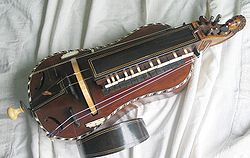
Back Rabil AST Hurdy Gurdy Azerbaijani Колавая ліра Byelorussian Колавая ліра BE-X-OLD Хърди-гърди Bulgarian Viola de roda Catalan Niněra Czech Drejelire Danish Drehleier German Vjelo Esperanto
This article needs additional citations for verification. (November 2022) |
 | |
| Other names | Wheel fiddle, wheel vielle, vielle à roue, zanfona, draailier, ghironda |
|---|---|
| Classification | String instrument (bowed) |
| Hornbostel–Sachs classification | 321.322-72 (Composite chordophone sounded by rosined wheel) |
| Playing range | |
 | |
| Related instruments | |
The hurdy-gurdy is a string instrument that produces sound by a hand-crank-turned, rosined wheel rubbing against the strings. The wheel functions much like a violin (or nyckelharpa) bow, and single notes played on the instrument sound similar to those of a violin. Melodies are played on a keyboard that presses tangents—small wedges, typically made of wood or metal—against one or more of the strings to change their pitch. Like most other acoustic stringed instruments, it has a sound board and hollow cavity to make the vibration of the strings audible.
Most hurdy-gurdies have multiple drone strings, which give a constant pitch accompaniment to the melody, resulting in a sound similar to that of bagpipes. For this reason, the hurdy-gurdy is often used interchangeably or along with bagpipes. It is mostly used in Occitan, Aragonese, Cajun French, Asturian, Cantabrian, Galician, Hungarian, and Slavic folk music. It can also be seen in early music settings such as medieval, renaissance or baroque music.[1] One or more of the gut strings called 'trompette' usually passes over a buzzing bridge called the 'chien' that can be made to produce a distinctive percussive buzzing sound as the player turns the wheel.
